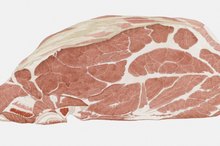What does fact checked mean?
At Healthfully, we strive to deliver objective content that is accurate and up-to-date. Our team periodically reviews articles in order to ensure content quality. The sources cited below consist of evidence from peer-reviewed journals, prominent medical organizations, academic associations, and government data.
The information contained on this site is for informational purposes only, and should not be used as a substitute for the advice of a professional health care provider. Please check with the appropriate physician regarding health questions and concerns. Although we strive to deliver accurate and up-to-date information, no guarantee to that effect is made.
What Is Cellulose in Vitamins?
If you've read over the ingredients on a bottle of vitamins, you may have noticed the ingredient "cellulose" and wondered what its purpose was. Cellulose isn't a vitamin -- it isn't even a nutrient, in fact -- but it does help make vitamin pills easier to bottle and swallow.
Cellulose
Cellulose in vitamins is simply fiber; it's the same molecule that you find in fiber-containing fruits, vegetables and whole grains. You can't digest fiber because you don't produce the necessary enzyme, which is called cellulase, explain Drs. Reginald Garrett and Charles Grisham in their book "Biochemistry." Chemically, fiber is very similar to starch -- it's made up of long chains of glucose molecules 1. Because you can't digest fiber, however, the glucose is inaccessible to you and fiber contains no calories.
- Cellulose in vitamins is simply fiber; it's the same molecule that you find in fiber-containing fruits, vegetables and whole grains.
- You can't digest fiber because you don't produce the necessary enzyme, which is called cellulase, explain Drs.
Vitamin Pills
Uses & Side Effects of Cellulose in Vitamins
Learn More
When you take vitamins, you're taking only a very small quantity of each vitamin and mineral -- where calcium is a notable exception. As a result, to make small quantities of vitamins into a pill that's large enough for you to take easily, manufacturers add cellulose. The fiber binds all the vitamins and minerals together, and also ensures that they're in solid form as opposed to liquid or powder.
Benefits
While there are many benefits of fiber to human digestion -- it helps regulate your digestive tract, binds cholesterol and toxins and helps keep your blood sugar stable -- the fiber or cellulose in vitamins doesn't do much for you. This is because you need relatively large quantities of fiber each day; women need 25 grams per day, and men need 38 grams. Compared to the required quantities, vitamin pills provide a minimal amount -- less than a gram.
Considerations
Prenatal Vitamins & Weight Loss
Learn More
For those vitamins that would otherwise be in liquid form, one benefit of a pill made with large quantities of inactive ingredients like cellulose is that it helps to prevent the vitamins from reacting before you consume them. Some vitamins, like C and E, are highly reactive. They can interact with air, and this reaction makes them inactive in the body. Pills help keep vitamins from reacting with air, making them more effective when you take them.
- For those vitamins that would otherwise be in liquid form, one benefit of a pill made with large quantities of inactive ingredients like cellulose is that it helps to prevent the vitamins from reacting before you consume them.
- They can interact with air, and this reaction makes them inactive in the body.
Related Articles
References
- “Biochemistry”; Reginald Garrett, Ph.D. and Charles Grisham, Ph.D.; 2007
- MedlinePlus: Fiber
Writer Bio
Kirstin Hendrickson is a writer, teacher, coach, athlete and author of the textbook "Chemistry In The World." She's been teaching and writing about health, wellness and nutrition for more than 10 years. She has a Bachelor of Science in zoology, a Bachelor of Science in psychology, a Master of Science in chemistry and a doctoral degree in bioorganic chemistry.









